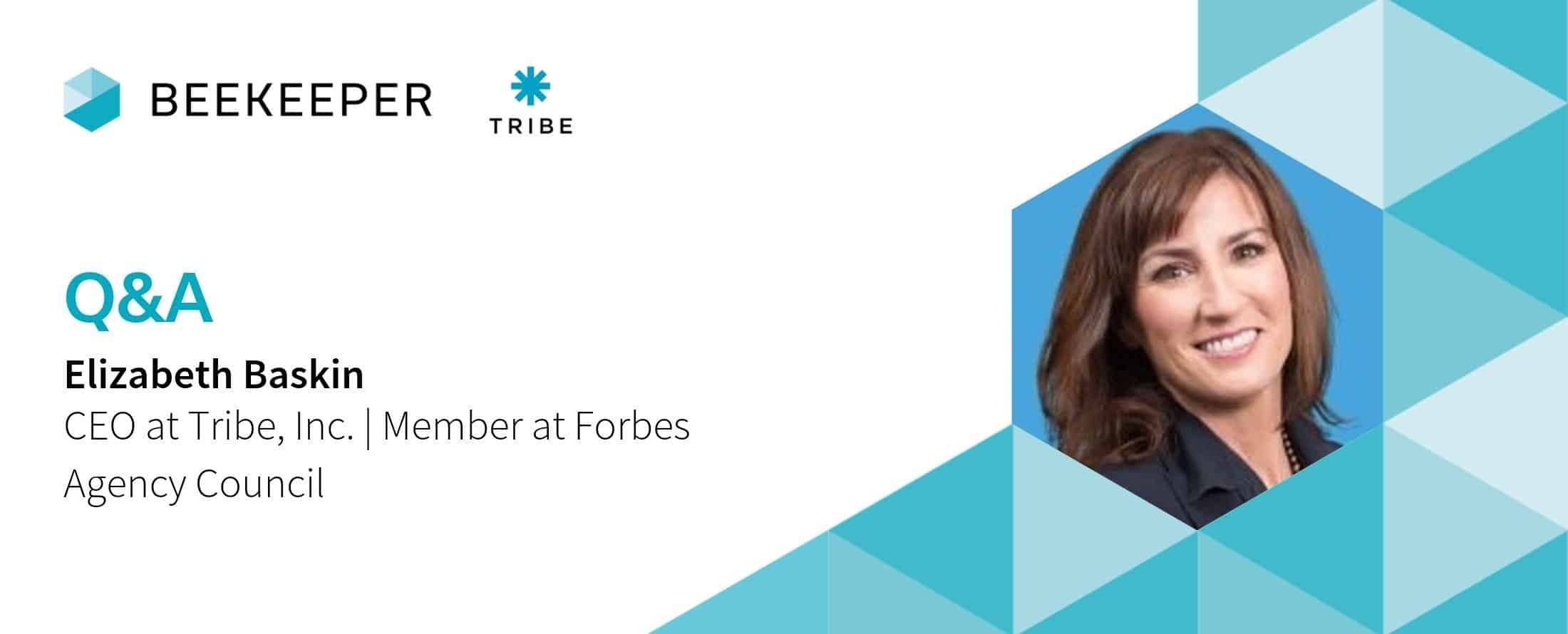We don’t use the term “pioneer” lightly around here. So, when we say that Elizabeth Baskin is a pioneer in the internal communications space, you know it’s the real deal.
Tribe Inc. is an internal communications company working with national and global brands to build employee engagement and internal culture.
Baskin founded Tribe in 2002 as a branding boutique and quickly grew the business to a $5 million company. In 2009, she launched Starter Cards LLC, a division of Tribe, to create content such as the Start Your Own Company iPhone application and the Social Media for Old Folks webinars.
Elizabeth Baskin is also the author of several books, including “Hell Yes! Two Little Words for a Simpler, Happier Life,” and ‘Run Your Business Like a Girl,” which profiled female entrepreneurs.
With a track record like that you can see why we were pretty excited to interview her.
Here’s what she had to say about the state of internal communications.
1) Tribe Inc. originally began as a branding boutique. How did it evolve into a multimillion internal communications agency?
That’s right, Tribe started as a creative boutique doing TV, magazines, and other traditional advertising for consumer brands. Some of our largest clients began giving us projects that were employee-facing rather than consumer-facing, and we found the work really interesting.
We also noticed there weren’t a ton of agencies out there applying a high level of creative and strategic thinking to internal comms. We made the commitment to focus only on internal communications in 2009, and we’ve spent the last decade deepening and broadening our experience in this niche.
2) How do you think the digital workplace supports internal communications and employee engagement within a company?
The digital workplace allows us to connect employees across geography. It’s something we almost take for granted, but really, the idea that we can create human connections and build relationships between employees spread out over many global locations is pretty great.
3) Where do you think the future of internal comms is headed? What are your top predictions?
I love the irony of technology allowing us to make internal communications more human. And that really, in my mind, is one of the primary goals of internal communications, to connect human beings and unite them in being part of something larger.
I’m sure technology will continue to offer us new options for communicating with and connecting employees. And at the same time, I predict low-tech solutions will also continue to be important.
4) What can companies do to boost engagement and improve communication with their frontline employees?
Most frontline employees are also non-desk employees, so they’re not sitting in front of a computer all day. That makes it harder to reach them, although not by any means impossible.
Tribe’s approach to communicating with non-desk employees is to go to where they are to see the physical realities of their workdays. How do they get to work? Where do they enter the building? Where do they take breaks?
During their shifts, are they standing, sitting, walking or driving a truck? We look for new touchpoints where we might reach employees, like huge murals on construction site chain-link fences or digital signage in the backroom of convenience stores. Mobile solutions are often a great way to reach the front line.
5) How can improving internal communication for frontline employees also improve the overall customer experience?
This is something we feel is really important for companies to recognize: The frontline employees are the ones delivering on the brand promise — or not. You can spend a zillion dollars on advertising, but the customer experience is shaped by that drive-thru cashier or flight attendant or customer service rep.
Those frontline employees are the face of the brand, so they need to know what it is they’re supposed to stand for. They also can be a great source of customer insights and innovative ideas, so having a two-way communication channel with frontline workers is a smart strategy.
6) How can companies leverage an internal communications strategy to improve employee retention rates?
Having an employer brand is an important element of the overall internal communications strategy. An authentic employer brand is useful for both recruiting and retention. It lets employees know what’s in it for them and reinforces the reasons they choose to work here instead of anywhere else.
Strong internal communications also support retention in a ton of different ways, from helping employees align with the company vision for success, to keeping them in the loop on company news; from recognition to breaking down silos to humanizing leadership. There are many layers of building engagement with internal communications, and that engagement then can improve retention.
7) What’s the most innovative internal communications initiative you’ve ever seen a company undertake?
One of my favorites was something we did with a hotel brand years ago. They were making innovation a business priority, so we launched a contest for employees throughout the chain to contribute innovative ideas.
The most important element of the contest was including those frontline workers — the employees in housekeeping, food and beverage and all those people in the heart of the house who have firsthand experience in the guest experience.
We went really low-tech to make sure we reached all those frontline employees, shipping a big folding cardboard kiosk to each hotel to go in the back-of-house. Each kiosk had paper entry slips in both English and Spanish.
If we were doing the same project now, I think mobile might replace that cardboard kiosk. Of course, we also offered the option of submitting entries online, and a lot of corporate employees submitted ideas that way, but most of the really interesting ideas came from people who scribbled them down on paper and dropped them into that cardboard kiosk.
Then leadership selected winning ideas, and we made celebrities of the employees submitting those ideas with videos, intranet, and newsletter articles and in-person recognition.
What I loved about it was that leadership acknowledged that those frontline employees knew things about the brand and the guest that it was impossible for them to know, sitting in their offices at corporate.







